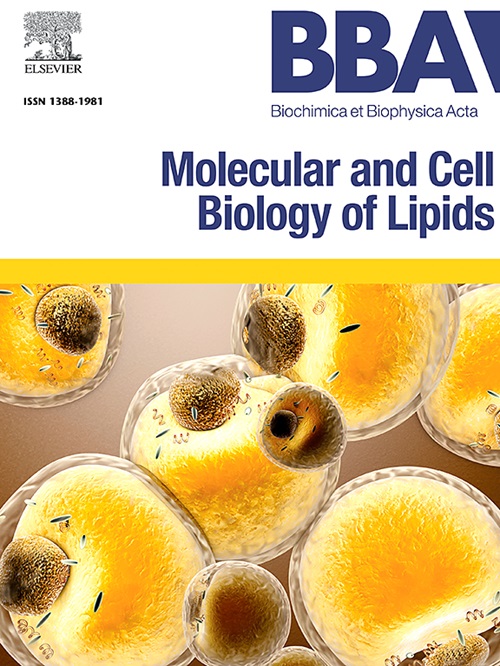Rapamycin induced autophagy enhances lipid breakdown and ameliorates lipotoxicity in Atlantic salmon cells
IF 3.3
2区 生物学
Q2 BIOCHEMISTRY & MOLECULAR BIOLOGY
Biochimica et biophysica acta. Molecular and cell biology of lipids
Pub Date : 2025-05-17
DOI:10.1016/j.bbalip.2025.159636
引用次数: 0
Abstract
Autophagy is a highly conserved cellular recycling process essential for homeostasis in all eukaryotic cells. Lipid accumulation and its regulation by autophagy are key areas of research for understanding metabolic disorders in human and model mammals. However, the role of autophagy in lipid regulation remains poorly characterized in non-model fish species of importance to food production, which could be important for managing health and welfare in aquaculture. Addressing this knowledge gap, we investigate the role of autophagy in lipid regulation using a macrophage-like cell line (SHK-1) from Atlantic salmon (Salmo salar L.), the world's most commercially valuable farmed finfish. Multiple lines of experimental evidence reveal that the autophagic pathway responsible for lipid droplet breakdown is conserved in Atlantic salmon cells. We employed global lipidomics and proteomics analyses on SHK-1 cells subjected to lipid overload, followed by treatment with rapamycin to induce autophagy. This revealed that activating autophagy via rapamycin enhances storage of unsaturated triacylglycerols and suppresses key lipogenic proteins, including fatty acid elongase 6, fatty acid binding protein 2 and acid sphingomyelinase. Moreover, fatty acid elongase 6 and fatty acid binding protein 2 were identified as possible cargo for autophagosomes, suggesting a critical role for autophagy in lipid metabolism in fish. Together, this study establishes a novel model of lipotoxicity and advances understanding of lipid autophagy in fish cells, with significant implications for addressing fish health issues in aquaculture.
雷帕霉素诱导的自噬增强了大西洋鲑鱼细胞的脂质分解并改善了脂肪毒性。
自噬是一种高度保守的细胞循环过程,对所有真核细胞的稳态至关重要。脂质积累及其自噬调控是理解人类和模式哺乳动物代谢紊乱的关键研究领域。然而,自噬在脂质调节中的作用在对食品生产具有重要意义的非模式鱼类中仍然缺乏特征,这可能对水产养殖的健康和福利管理很重要。为了解决这一知识空白,我们利用大西洋鲑鱼(Salmo salar L.)的巨噬细胞样细胞系(SHK-1)研究了自噬在脂质调节中的作用,大西洋鲑鱼是世界上最具商业价值的养殖鱼类。多种实验证据表明,大西洋鲑鱼细胞中负责脂滴分解的自噬途径是保守的。我们对脂质过载的SHK-1细胞进行了全球脂质组学和蛋白质组学分析,随后用雷帕霉素诱导自噬。这表明,通过雷帕霉素激活自噬可以增强不饱和三酰甘油的储存,并抑制关键的脂肪生成蛋白,包括脂肪酸延长酶6、脂肪酸结合蛋白2和酸性鞘磷脂酶。此外,脂肪酸延长酶6和脂肪酸结合蛋白2被确定为自噬体的可能货物,表明自噬在鱼类脂质代谢中起关键作用。总之,本研究建立了一种新的脂肪毒性模型,并推进了对鱼类细胞脂质自噬的理解,对解决水产养殖中鱼类健康问题具有重要意义。
本文章由计算机程序翻译,如有差异,请以英文原文为准。
求助全文
约1分钟内获得全文
求助全文
来源期刊
CiteScore
11.00
自引率
2.10%
发文量
109
审稿时长
53 days
期刊介绍:
BBA Molecular and Cell Biology of Lipids publishes papers on original research dealing with novel aspects of molecular genetics related to the lipidome, the biosynthesis of lipids, the role of lipids in cells and whole organisms, the regulation of lipid metabolism and function, and lipidomics in all organisms. Manuscripts should significantly advance the understanding of the molecular mechanisms underlying biological processes in which lipids are involved. Papers detailing novel methodology must report significant biochemical, molecular, or functional insight in the area of lipids.

 求助内容:
求助内容: 应助结果提醒方式:
应助结果提醒方式:


